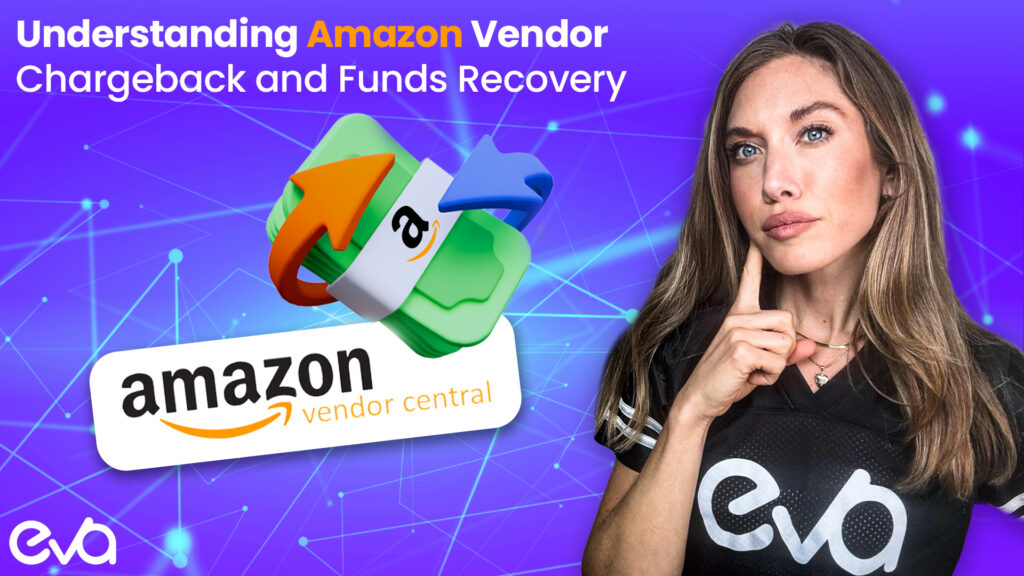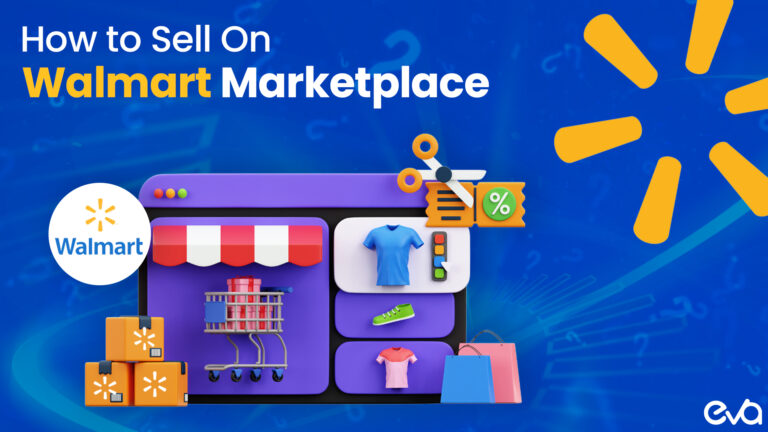For vendors selling through Amazon Vendor Central, managing chargebacks has become an increasingly critical aspect of business operations. With Amazon’s stringent requirements and complex compliance standards, these financial penalties can significantly impact a company’s bottom line.
This guide provides a detailed overview of Amazon vendor chargebacks and proven strategies to help protect your business from costly penalties.
Table of Contents
- Understanding Amazon Vendor Chargebacks
- Common types of chargebacks include:
- Additional Chargebacks
- Prevention Best Practices
- Shortages: Inventory and Pricing
- Prevention and Documentation
- The Financial Impact
- How Eva Commerce Can Help
- Effective Strategies for Chargeback and Shortage Management
- FAQs
- Conclusion
Understanding Amazon Vendor Chargebacks
Amazon Vendor Central chargebacks are more than just simple penalties – they’re part of Amazon’s sophisticated vendor management system designed to maintain operational excellence across their vast marketplace.
These charges serve multiple purposes: they compensate Amazon for operational disruptions, incentivize vendors to meet performance standards, and help standardize processes across the platform.
Understanding the intricate nature of these chargebacks is the first step toward preventing them and maintaining a profitable relationship with Amazon.
Common types of chargebacks include:
- PO On-Time Accuracy: Penalties for not meeting purchase order deadlines.
- ASN Accuracy: Advanced Shipment Notice errors, such as incorrect or incomplete information.
- Labeling Issues: Problems with product labeling, including missing or incorrect labels.
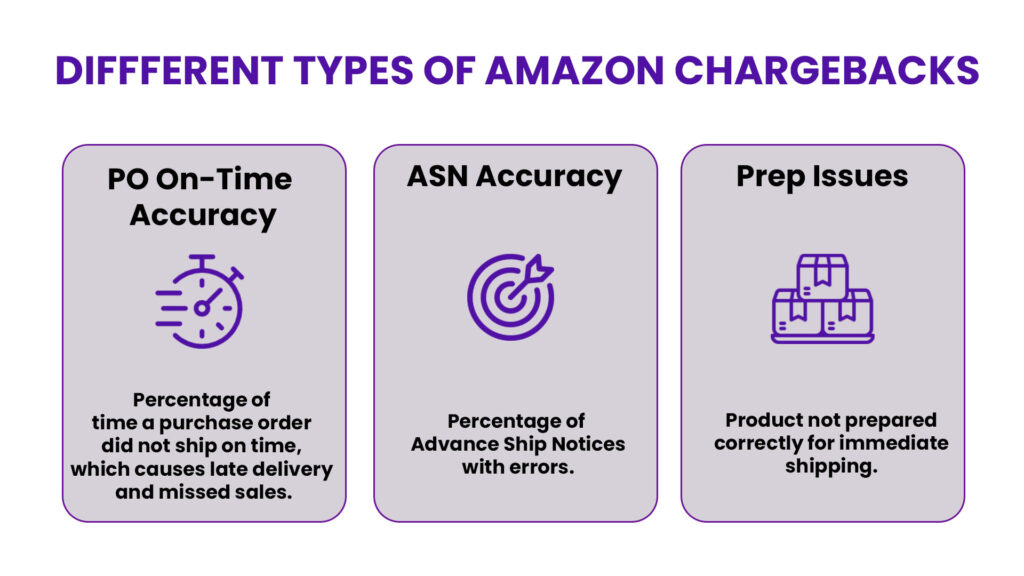
Additional Chargebacks
Purchase Order (PO) Compliance
- On-Time Accuracy Penalties: Charged when vendors fail to meet purchase order deadlines or Amazon delivery timelines
- Order Defect Penalties: Applied when shipped quantities don’t match PO specifications
- Order Confirmation Delays: Penalties for late confirmation of purchase orders
- Fill Rate Issues: Charges for incomplete order fulfillment
Shipping and Delivery
- Late Shipment Penalties: Applied when deliveries occur outside agreed-upon timeframes
- Delivery Window Violations: Charges for arriving outside scheduled delivery appointments
- Carrier Compliance Issues: Penalties for using non-approved shipping carriers
- Transportation Routing Violations: Fees for not following Amazon’s routing guidelines
Documentation and Information
Advanced Shipping Notice (ASN) Errors: For successful chargeback prevention, properly manage your ASN document to avoid penalties for:
- Late ASN submissions
- Inaccurate product information
- Missing or incorrect tracking details
- Discrepancies between ASN and actual shipment
Invoice Discrepancies: Charges for mismatched invoice and PO information
Product Preparation and Packaging
Labeling Non-Compliance: Understanding Amazon labeling rules is crucial to avoid penalties for:
- Missing or incorrect barcodes
- Non-standard label placement
- Unreadable or damaged labels
- Mixed SKUs with incorrect labels
Packaging Standards Violations: Charges for:
- Inadequate protective packaging
- Non-compliant box sizes
- Improper palletization
- Missing required packaging elements
Prevention Best Practices
For successful Amazon chargeback prevention, vendors need to establish comprehensive operational protocols and quality control measures.
By implementing robust preventive strategies and maintaining meticulous documentation, businesses can significantly reduce their exposure to costly chargebacks and maintain compliance with Amazon’s strict vendor requirements.
To minimize exposure to chargebacks, vendors should focus on the following key areas:
Implement Systematic Quality Controls
- Regular staff training on Amazon’s requirements
- Automated compliance checking systems
- Standard operating procedures for all Amazon shipments
- Regular internal audits of shipping processes
Maintain Clear Documentation
- Detailed records of all shipments and communications
- Photographic evidence of packaging compliance
- Time-stamped delivery confirmations
- Complete audit trails for dispute resolution
Shortages: Inventory and Pricing
Shortages represent a distinct challenge in the Amazon vendor ecosystem, manifesting in two primary forms; inventory, and pricing.
Understanding and tracking these shortages is crucial, as they can significantly impact your business’s cash flow and relationship with Amazon. Many vendors find themselves dealing with substantial deductions that can accumulate over time if not properly managed and disputed.
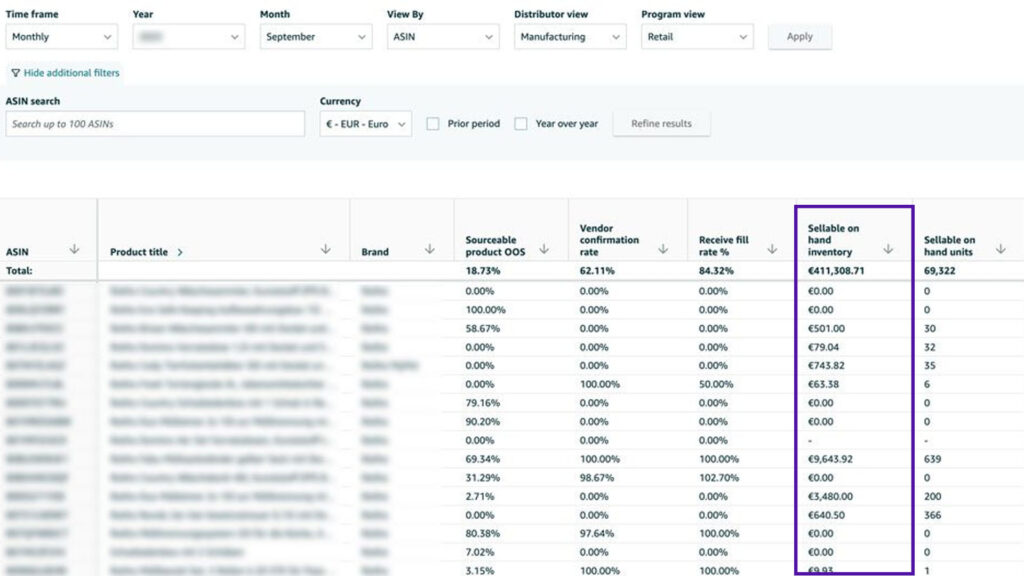
Inventory Shortages
Inventory shortages occur when Amazon reports receiving fewer units than the vendor claims to have shipped. These discrepancies can arise at various points in the supply chain and often present complex challenges for resolution. Common causes include:
Receiving Process Discrepancies
Amazon’s high-volume receiving operations can sometimes result in counting errors or misplaced inventory. These issues may occur due to:
- Multiple receiving points handling the same shipment
- High-speed automated scanning systems missing items
- Temporary storage in overflow areas without proper documentation
Physical Product Issues
- Damaged goods that are rejected during the receiving process
- Products separated from their original shipment
- Items lost or misplaced during transit or warehouse transfers
- Packaging problems leading to uncountable or unrecognizable items
Pricing Shortages
Pricing shortages arise when Amazon’s payment differs from the agreed-upon price, creating financial discrepancies that can significantly impact a vendor’s revenue. These shortages can be particularly challenging to track and resolve due to their complexity.
Common Causes
- Outdated or incorrect pricing information in Amazon’s system
- Promotional pricing errors or miscommunication
- Cost reconciliation issues across multiple purchase orders
- Delayed price updates not properly applied to orders
System-Related Issues
- EDI transmission errors affecting price updates
- Mismatched pricing across different Amazon systems
- Temporary system glitches during price adjustments
- Incomplete or incorrect cost file uploads
Prevention and Documentation
To minimize the impact of both inventory and pricing shortages, vendors should implement robust tracking and documentation systems:
Maintain detailed records of:
- All shipment quantities with supporting documentation
- Pricing agreements and changes with timestamps
- Communication history regarding price updates
- Photographic evidence of shipment contents when possible
Establish Standard Operating Procedures:
- Regular reconciliation of shipping records
- Systematic price update verification processes
- Clear communication protocols with Amazon support
- Regular audits of received vs. shipped quantities
The Financial Impact
The financial implications of Amazon vendor chargebacks and shortages can be substantial and far-reaching. Beyond immediate monetary losses, these penalties can create long-term challenges that affect your business’s growth potential and competitive position in the marketplace:
Market Impact
Studies indicate that chargebacks and shortages resulted in approximately $18 billion in losses across 2022 and 2023, with projections suggesting this figure could reach $20 billion by the end of 2024. This dramatic increase reflects both the growth of Amazon’s vendor network and increasingly stringent compliance requirements.
Profit Margin Erosion
Recent data shows vendors typically experience fees ranging from 6% to 22% of their shipped costs, a notable increase from previous years. This higher percentage reflects Amazon’s tightened compliance standards and more sophisticated tracking systems implemented in late 2023.
For small to medium-sized vendors, these increased charges can represent a significant threat to profitability.
Operational Consequences
- Continuous non-compliance can strain the vendor-Amazon relationship
- Regular chargebacks can lead to reduced order volumes
- Frequent penalties may result in deprioritization within Amazon’s system
How Eva Commerce Can Help
Eva Commerce is dedicated to helping brands achieve profitable growth on Amazon and other marketplaces. Here’s how Eva’s AI-powered platform and expert support can transform your business:
- Comprehensive Analysis: Eva’s platform integrates inventory levels, conversion rates, and profitability metrics to provide a holistic view of your business.
- Proactive Management: Our experts analyze data to determine the best actions for your advertising campaigns, ensuring maximum efficiency and ROI.
- Industry Partnerships: As an Amazon Advanced Partner and Walmart Strategic Solution Partner, Eva collaborates with industry giants like TikTok, eBay, Shopify, Google, Meta, Wayfair, and Faire.
Let us take your Amazon business to the next level. Book a free consultation with Eva Commerce.
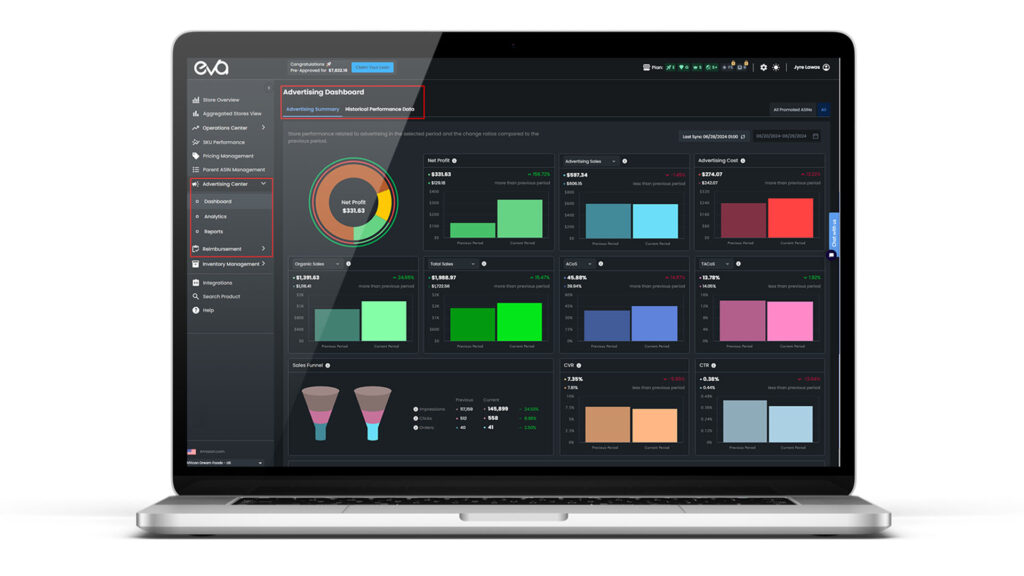
Effective Strategies for Chargeback and Shortage Management
Success in managing Amazon vendor chargebacks requires a multi-faceted approach that combines preventive measures with strategic response capabilities. By implementing comprehensive management strategies, vendors can significantly reduce their exposure to chargebacks while maintaining efficient operations:
Implement Rigorous Shipping Protocols
- Establish detailed quality control processes with double-verification of quantities and labeling accuracy
- Maintain comprehensive documentation and standardized checklists for all shipment procedures
Leverage Technology Solutions
- Deploy integrated systems for real-time compliance monitoring and automated warehouse management
- Implement quality control software that reduces human error while increasing accuracy
Develop a Robust Dispute Management Process
- Create a dedicated team with clear dispute submission timelines and organized documentation procedures
- Implement a strategic approach to chargeback disputes, including batch processing for enhanced visibility
Optimize Operational Efficiency
- Invest in comprehensive staff training while maintaining clear communication channels with Amazon
- Establish preventive measures based on historical data and regular policy updates
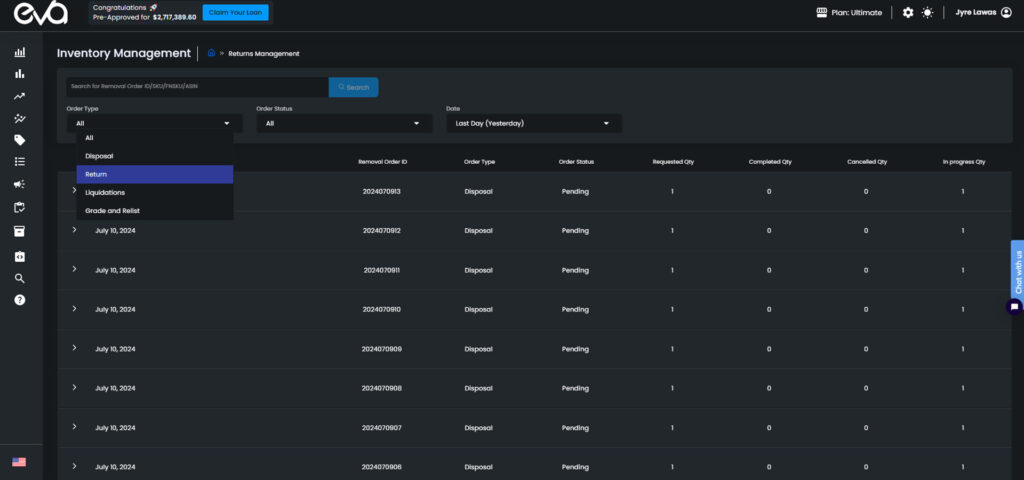
FAQs
Chargebacks are fees imposed by Amazon for non-compliance with their requirements, such as late shipments or incorrect labeling.
Preventing chargebacks involves understanding the root causes and implementing best practices, including accurate ASNs and proper labeling.
Inventory shortages occur when there is a discrepancy between the quantity shipped and the quantity received by Amazon.
Eva Commerce’s platform analyzes data to identify issues and provides proactive management to minimize chargebacks.
The look-back period for recovering shortages can extend up to five years.
Yes, but chargebacks must typically be disputed within 30 days of the charge being imposed.
Documentation such as shipment records and inventory logs can be helpful, but Eva Commerce pulls relevant data directly from Amazon to support disputes.
The recovery time can vary, with initial disputes resolved within 30 to 60 days, but more complex cases may take longer.
Eva Commerce charges a commission based on recovered funds, with a standard engagement fee and a two-phase commission structure.
You can start by booking a free audit with Eva Commerce to assess your current situation and identify potential recovery opportunities.
Conclusion
Successfully managing Amazon vendor chargebacks requires a balanced approach of prevention, monitoring, and strategic response. By implementing robust shipping protocols, leveraging technology, and maintaining strong operational practices, vendors can significantly reduce their exposure to chargebacks and shortages.
Key takeaways for vendors:
- Proactive prevention is more cost-effective than reactive management
- Regular monitoring and quick response to issues is crucial
- Investment in proper training and systems pays dividends
- Building a systematic approach to compliance helps ensure long-term success
By following these guidelines and maintaining vigilant oversight of vendor operations, businesses can minimize the impact of chargebacks while maintaining a profitable and sustainable relationship with Amazon.
Eva Commerce offers a powerful AI-driven platform and expert support to help you navigate these challenges and achieve sustainable growth.
Ready to optimize your Amazon business? Book a free consultation with Eva Commerce today.

